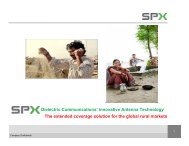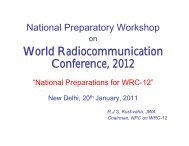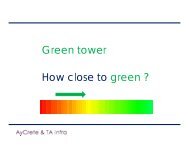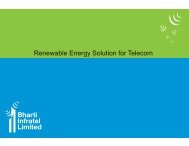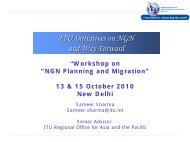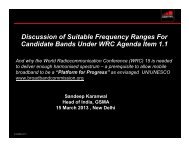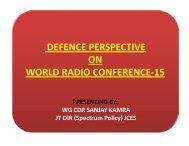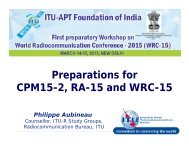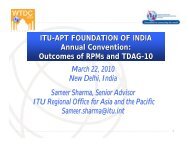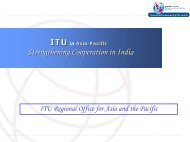Mr. Bharat Bhatia, Director, Motorola & Vice President, ITU-APT ...
Mr. Bharat Bhatia, Director, Motorola & Vice President, ITU-APT ...
Mr. Bharat Bhatia, Director, Motorola & Vice President, ITU-APT ...
Create successful ePaper yourself
Turn your PDF publications into a flip-book with our unique Google optimized e-Paper software.
Equitable Communication for All<br />
Regulatory and Policy Aspects<br />
<strong>Bharat</strong> <strong>Bhatia</strong><br />
<strong>President</strong>, CTIA India<br />
Chairman, RWG, WiMax forum India Chapter<br />
<strong>Vice</strong> <strong>President</strong>, <strong>ITU</strong>-<strong>APT</strong> Foundation of India<br />
Regional <strong>Director</strong>, Asia, <strong>Motorola</strong>
oday The Mobile Phones are the Best Providers of<br />
quitable Communication for All<br />
CONNECT ME<br />
ENTERTAIN ME SECURE ME EMPOWER ME<br />
INFORM ME
And India is leading this Mobility dream for all<br />
WORLD POPULATION<br />
4 Births per second<br />
MOBILE PHONE<br />
32 Sold per second<br />
More then 13 of them in Asia*<br />
More then 7 of them in India<br />
e: Research and Markets<br />
TOROLA and the Stylized M Logo are registered in the US Patent & Trademark Office. All other product or service names are the property of their respective owners. © <strong>Motorola</strong>, Inc. 2008.
India is The Fastest Growing Country in Mobility<br />
ian Telecom<br />
tistics<br />
al Telephone<br />
scriber Base<br />
December 09<br />
543.20 million<br />
700<br />
600<br />
• India is the faste<br />
growing cellular<br />
market in the<br />
world<br />
eless Subscription<br />
Additional in<br />
eless<br />
rall Teledensity 46.32<br />
adband Subscription<br />
506.04 million<br />
17.65 million<br />
7.57 million<br />
500<br />
400<br />
300<br />
200<br />
100<br />
0<br />
Mobile Wireless<br />
Subscribers<br />
Wireline<br />
Subscribers<br />
2003 2004 2005 2006 2007 2008 2009 2010<br />
• Has become the<br />
2 nd largest mark<br />
after china earl<br />
in 2009<br />
• India is adding<br />
18-20 Million ne<br />
wireless<br />
subscribers eve<br />
month<br />
Source : TRAI Press Release , December 09
ndia’s s mobility solutions have redefined the<br />
lobal rules<br />
owest Mobile tariffs in the World<br />
ery high and rising Minutes of Use<br />
ompared to many countries<br />
ow and Falling SMS prices leading to:<br />
widening user demographic and<br />
increasing number of SMS based services.<br />
0.25<br />
0.2<br />
0.15<br />
0.1<br />
0.05<br />
0<br />
0.23<br />
Belgium<br />
0.22<br />
Italy<br />
0.19<br />
UK<br />
0.17<br />
France<br />
0.16<br />
Brazil<br />
0.11 0.11 0.11<br />
Philippines<br />
Taiwan<br />
Argentina<br />
Average Call Charges<br />
0.09<br />
Malayasia<br />
0.05 0.05<br />
Hong Kong<br />
Thailand<br />
0.04<br />
Pakistan<br />
0.03<br />
China<br />
461<br />
SMS Volumes in billions<br />
12.3<br />
20.6<br />
SMS Volume<br />
33.1<br />
50.7<br />
89.4<br />
140.2<br />
180<br />
84<br />
Minutes of Use<br />
159<br />
179<br />
315<br />
320 323 326<br />
2004 2005 2006 2007 2008 2009 2010<br />
Russia M alaysia Australia Korea Singapore China Thailand India
But the Equitable communications can no<br />
be achieved without Broadband growth<br />
World Regions<br />
Population<br />
(2009 Est)<br />
Internet Users<br />
Latest Data<br />
Penetration<br />
(% Population)<br />
Africa 991,002,342 65,903,900 6.7<br />
Asia<br />
3,808,070,503<br />
704,213,930<br />
18.5<br />
Europe<br />
803,850,858<br />
402,380,474<br />
50.1<br />
Middle East<br />
202,687,005<br />
47,964,146<br />
23.7<br />
North America<br />
340,831,831<br />
251,735,500<br />
73.9<br />
Latin America/Caribbean<br />
586,662,468<br />
175,834,439<br />
30.0<br />
Oceania / Australia<br />
34,700,201<br />
20,838,019<br />
60.1<br />
WORLD TOTAL<br />
6,676,805,208<br />
1,668,870,408<br />
24.7<br />
Total Worldwide Broadband Subscribers 6-7%<br />
http://www.internetworldstats.com/stats.h
“Broadband “A “World growing majority Bank, of share adoption Information home of broadband appears and Communications<br />
to users have see a<br />
been home subscribers for Development largely high-speed is immune paying 2009, connection to for found the premium effects as that “very for of every the important” 10<br />
current to service percentage-point at least economic that one gives dimension increase recession.” them faster of in their high-speed speeds.” lives and<br />
community, Internet connections such as communicating there is an increase with health in<br />
care economic providers growth and of government 1.3 percentage officials, points.” or<br />
gathering and sharing information about the<br />
community.”
n-line Media Will Continue to Drive Broadband Demand…<br />
arger page size = need for bandwidth<br />
ore objects = need for low latency<br />
Web Page Size / Complexity Increasin<br />
% of the total mobile traffic will be data<br />
2015*<br />
ome <strong>Motorola</strong> 4G deployments report<br />
5 GByte / Sub / Month average<br />
obile Data Traffic increases 10x by 2015 but<br />
venue/MB will decline by 7x *<br />
obile Data Traffic doubles annually for the next 4<br />
ars **<br />
*Source: Analysys Mason – 4/09h<br />
**Source: Cisco VIN 2009<br />
Source: WebsiteOptimization.com, April, 2008.
obile Market Dynamics<br />
bile operators facing increased competition<br />
Target Lower Cost per Bit<br />
Fixed line operators going mobile<br />
New entrants (ISP/Cable going WiMAX)<br />
MVNO<br />
bile voice value is falling<br />
ed-line Broadband setting expectations<br />
Legal environment pressure<br />
Unbundled tariffs<br />
Fixed line / VoIP prices<br />
Voice & SMS<br />
Latency - 10-50ms<br />
dominated<br />
Bandwidth – 4Mbps<br />
traffic<br />
+<br />
Access to all contents<br />
Traffic<br />
obile data becoming a reality<br />
ta demand increasing / Reaching capacity<br />
User experience improvement – HSPA / devices<br />
Revenue<br />
Flat rate mobile data tariffs<br />
Laptops built-in HSPA chipsets Mobile Data Explosion<br />
Walled garden opening up / New Exciting apps<br />
More people signing up to flat rate mobile data tarriff<br />
Subscriber using more and more Time data (USB dongles – laptop impact)<br />
HSPA network reaching Operator capacity Traffic / HPSA & Revenue Spectrum Challenge exhaustion
treaming Video Fills Up the Pipes…<br />
% of users watch online video<br />
uTube = 27% of internet traffic<br />
2 B video streams per day<br />
Reasonable Use Profiles<br />
Road Warrior<br />
Laptop + Mobile<br />
Urban Professional<br />
Laptop + Mobile<br />
% of all IP traffic will be Video by 2013 *<br />
pproximately 64 percent of the world's mobile<br />
ta traffic will be video by 2013*<br />
Days KB / Hrs<br />
Kbps KB / Mo<br />
APPS<br />
/ Mo Day /day<br />
VoIP/Conference on Mobile 20 1 64 576,000<br />
VoIP on Mobile<br />
Netmeeting when Out of Office<br />
30<br />
4<br />
Video<br />
0.1<br />
0.5<br />
65<br />
500<br />
87,750<br />
450,000<br />
Outlook (100 emails + 25 with attachments) 4 220,000<br />
55000<br />
Outlook (100 emails + 25 with attachments but<br />
30 16000<br />
only 5 attachments download)<br />
Communicator<br />
2.4GB/month<br />
4 8<br />
480,000<br />
3 43,200<br />
Linked-In, profile update, video stream up and<br />
2 1 128 115,200<br />
down<br />
Competitor sites, News sites, etc… (Bursty traffic) 4 1 100 180,000<br />
Home recorded movie on hard drive set top box /<br />
2 2 1000 1,800,000<br />
Sling / Computer<br />
Youtube, News clip 10 0.5 256 576,000<br />
Radio streaming and home stored music 10 1 128 576,000<br />
Gbytes / Month 5.1<br />
5.1GB/month<br />
College Student<br />
Laptop + Mobile<br />
APPS<br />
Days<br />
/ Mo<br />
KB /<br />
Day<br />
Hrs<br />
/day<br />
Kbps<br />
VoIP on Mobile 30 0.1 64<br />
Outlook (20 emails + 5 with attachments) 4 11000<br />
Outlook (20 emails + 5 with attachments) 30 11000 3<br />
Live Messenger (assuming it replaces SMS) 30 4<br />
10.0 3<br />
MySpace/Facebook, profile update, video stream<br />
5 0.5 128 1<br />
up and down<br />
General Browsing, Music + News sites, etc… 10 0.5 100 2<br />
Home recorded movie on hard drive set top box /<br />
4 2.0 1000 3,6<br />
Sling / Computer<br />
Youtube, News clip 10 0.3 256 3<br />
Radio streaming and home stored music 15 1.0 128 8<br />
Gbytes / Month 6<br />
Typical<br />
Mobile only<br />
Video<br />
3.9GB/month<br />
6GB/month<br />
KB<br />
APPS<br />
Days<br />
/ Mo<br />
KB /<br />
Day<br />
Hrs<br />
/day<br />
Kbps<br />
KB / Mo<br />
APPS<br />
Days<br />
/ Mo<br />
KB /<br />
Day<br />
Hrs<br />
/day<br />
Kbps<br />
KB<br />
Video<br />
4.5GB/month<br />
VoIP on Mobile 30 0.2 64 172,800<br />
Outlook (10 emails + 5 with attachments) 30 10500 315,000<br />
Outlook (10 emails + 5 with attachments) 30 10500 315,000<br />
Live Messenger (assuming it replaces SMS) 30 10.0 3 405,000<br />
MySpace/Facebook, profile update, video stream<br />
10 0.3 128 172,800<br />
up and down<br />
General Browsing, Music + News sites, etc… 20 1.0 100 900,000<br />
Home recorded movie on hard drive set top box /<br />
Sling / Computer<br />
6 2.0 1000 5,400,000<br />
11.1GB/month<br />
Youtube, News clip 20 0.5 256 1,152,000<br />
Radio streaming and home stored music 20 2.0 128 2,304,000<br />
Gbytes / Month 11.1<br />
Video<br />
1.2GB/month<br />
VoIP on Mobile 30 0.5 64 4<br />
Outlook (5 emails + 3 with attachments) 20 6250 1<br />
General Browsing, Price check + News sites,<br />
20 1.0 100 9<br />
etc…<br />
2.7GB/month<br />
Youtube, News clip 20 0.5 256 1,1<br />
Radio streaming and home stored music 4 0.5 128 1<br />
Gbytes / Month 2<br />
* Source: Cisco VIN 2009
ew Mobile Data Usage Patterns<br />
hat Do Tech Savvy Millennials (16 to 27-yr<br />
yr-olds) Demand?<br />
“How much interest do you have in the following circumstances?”<br />
Option to shift TV programs from STB at<br />
home to a mobile device<br />
Watching movies while traveling<br />
Watching 15-min mobile versions of a<br />
30-min TV program<br />
Watching 3-min version of favorite<br />
shows on mobile device<br />
81%<br />
75%<br />
62%<br />
61%<br />
indings based on an online panel survey among over 2,000 members of the Millennial generation ages 16-27<br />
Next Generation Data Drivers<br />
Web 2.0 and Multi-media Content<br />
Number of U.S. mobile devic<br />
users accessing the Internet<br />
more than doubled from 2008<br />
to 2009<br />
27M mobile TV users in<br />
Japan and South Korea<br />
$5.4 Bn worldwide mobile<br />
gaming revenue in 2008<br />
China revenue up ~40% in 2<br />
>250M active users<br />
30M users accessing Faceb<br />
through their mobile device<br />
1.2 Billion streams from<br />
YouTube per day<br />
Source: co
India’s s billion+ people need Low Cost and<br />
Spectrum Efficient Mobile broadband<br />
Almost Non Existent Wireline networks<br />
Availability of broadband wireless technologies such as LTE and<br />
WiMax at competitive costs<br />
New spectrum available in 700 MHz band for Broadband mobility<br />
and solutions<br />
Lower Costs for subscribers<br />
Faster Roll out
obile Broadband Wireless Technologies are all<br />
volving to OFDM which meet our needs<br />
2G<br />
2G 3G 4<br />
1992<br />
1994<br />
1998 2000<br />
2002<br />
2004<br />
2006<br />
2007<br />
2009<br />
2010<br />
3GPP<br />
GSM UMTS HSDPA HSUPA<br />
LTE<br />
LTE -Adv<br />
GPP2<br />
OFDMA<br />
IS95A 1X DO DO Rev A UMB<br />
IEEE<br />
802.11 b/g<br />
802.16d 802.16e WiMAX<br />
802.16m
DMA Mobile Broadband Wireless Technologies provide<br />
ter data rates and low latency<br />
GE<br />
DSL<br />
40-100Mbps<br />
Fiber like speed on mobile<br />
EDGE<br />
ADSL<br />
30-10msec latency<br />
Highly Responsive Multimedia<br />
VDO-A<br />
DPA<br />
DSL-2+<br />
WiMAX<br />
iber<br />
aster data rates<br />
Mbps<br />
+ True high-speed mobile data<br />
+ Full-motion HD video anywhere<br />
+ Stream any content<br />
+ Quadruple play<br />
+ Faster email access and Instantaneous<br />
web pages<br />
EVDO-A<br />
HSDPA<br />
ADSL-2+<br />
LTE/WiMAX<br />
Fiber<br />
Low Latency<br />
+Improved user experience<br />
+Fast VoIP call set-up<br />
+Instantaneous web pages<br />
+Streaming fast buffering<br />
+Online mobile gaming<br />
msec
OFDMA Wireless Technologies are key to broadband<br />
connectivity in India<br />
1-8Mbps expected<br />
User bandwidth<br />
$<br />
10%<br />
UMTS rel.99 voice call cost<br />
LTE/WIMAX VoIP cost*<br />
much lower call costs<br />
-100Mbps Sector Throughput<br />
re capacity per user<br />
ectrum Bandwidth<br />
to 20MHz<br />
ectrum Efficiency<br />
ch higher bits/sec/Hz<br />
105 Simultaneous<br />
Calls per sector / 1MHz<br />
Highly spectrum efficient<br />
+ Spectrum Flexibility<br />
Flexible Bandwidth (1.25 MHz to 20 MHz)<br />
Expand spectrum as demand grows<br />
+ Centralized IMS services<br />
Easy to upgrade application capacity<br />
+ Voice Capacity<br />
Up to 105 VoIP calls per sector per MHz*<br />
+ Low frequency, Advanced Receivers and<br />
Smart Antenna<br />
For improved coverage and reduced<br />
cost of ownership<br />
+ Simpler RAN, IP Core & Centralized<br />
service delivery<br />
Fewer nodes & interfaces (Node-B/RNC/Gateway)<br />
One Network & IMS for all access technologies<br />
+ 3GPP Market traction<br />
Economy of scale
olices and Regulations have driven the mobile growth in India<br />
Department of Telecommunication (DoT) is the main body formulating laws and various<br />
regulations for the Indian telecom industry.<br />
INDIA<br />
Private players<br />
were allowed in<br />
Telecom Services<br />
1992<br />
1994<br />
National Telecom<br />
Policy (NTP) was<br />
formulated<br />
Independent<br />
regulator, TRAI,<br />
was established<br />
1997<br />
1999<br />
BSNL was<br />
established by<br />
DoT<br />
2000<br />
NTP-99 led to migration<br />
from high-cost fixed<br />
license fee to low-cost<br />
revenue sharing regime<br />
ILD services was<br />
opened to competition<br />
2002<br />
Reduction of<br />
licence fees<br />
Calling Party Pays<br />
CDMA technology (CPP) was<br />
For Mobile Services implemented<br />
permitted<br />
Internet<br />
telephony<br />
initiated<br />
2003<br />
Unified Access<br />
Licensing (UASL)<br />
regime was<br />
introduced<br />
Reference<br />
Interconnect<br />
order was issued<br />
2004<br />
Intra-circle merger<br />
guidelines were<br />
established<br />
Broadband policy<br />
2004 was<br />
formulated—<br />
targeting 20 million<br />
subscribers by<br />
2010<br />
Attempted to<br />
boost Rural<br />
telephony<br />
2005<br />
Number portability w<br />
proposed (pending)<br />
2006<br />
2007<br />
Decision on 3G<br />
FDI limit was services (await<br />
increased from 49 to<br />
74 percent<br />
But New Policies and Regulatory initiatives are<br />
essential to expand rural broadband<br />
ILD – International Long Distance<br />
16
Our Policy environment is still far from perfect<br />
dependent Regulator<br />
onvergence Law<br />
pectrum Management<br />
egulation for all IP NGN regime<br />
dustry participation & self regulation
Current Regulatory Framework<br />
PSTN Cellular Cable Satellite Broadcast<br />
VOICE<br />
DATA<br />
VIDEO
New Paradigm - examples<br />
PSTN<br />
Wired Networks<br />
TDMA/CDMA<br />
TDM based back-haul<br />
Voice<br />
Broadcast TV<br />
NGN-IP Networks<br />
Wireless<br />
OFDMA<br />
IP backhaul<br />
VOIP<br />
IPTV<br />
Users linked to one network with<br />
limited services<br />
Greater user choice<br />
Lower cost<br />
High speed Integrated IP networks
Applications<br />
(Global Servers / Services)<br />
Technology Scenario<br />
Regulatory Challenges<br />
Global Service creation and<br />
service provision<br />
Service Convergence<br />
New concept of Services (billing,<br />
revenue sharing, interconnection)<br />
De-regulated licensing environment for<br />
Service Creation, Service Provision for<br />
local, domestic long distance and<br />
international<br />
“Establish a unified & rationalized regulatory paradigm for new<br />
advanced IP-enabled services that are agnostic to the platform or<br />
location.”
Core Networks<br />
Technology Scenario<br />
Regulatory Challenges<br />
“Data, Cellular and Fixed Network<br />
convergence.”<br />
Growing & Intense use of IP<br />
Protocol<br />
Conventional Switching Offices<br />
replaced by Soft-Switches.<br />
‣Regulatory Framework that facilitates<br />
Convergence.<br />
‣Remove all barriers to the use of IP<br />
Protocols, especially VoiP.<br />
“Do what users want but do it seamlessly, any<br />
complexity should be behind the scenes.”
Devices<br />
Technology Scenario<br />
“Always on, always here” with a<br />
single device.<br />
Regulatory Challenges<br />
‣Unlicensed bands<br />
Increasing Use of low power<br />
wireless technologies – RFD,NFC,<br />
‣Type approval of single devices<br />
multiple applications.<br />
Multiple Technologies and bands<br />
in a single device<br />
‣Rules for Global roaming<br />
“Devices have moved from a single phone with wires to a broad<br />
ranging wireless IP and multimedia devices.”
Opérator 3<br />
ideo content<br />
e new regulatory framework needs to Allow competition between content and<br />
velopment of innovating and disruptive services<br />
Common services shared<br />
with all broadcasters (broadcasted)<br />
+ TV5<br />
Specific services for<br />
one or more operators<br />
(broadcasted)<br />
MVNO<br />
Opérator 1<br />
Opérator 2<br />
Specific service for one operator<br />
and for limited audience<br />
(over 3G)
Access<br />
Future Scenario<br />
Regulatory Challenges<br />
Rapid Growth of high speed<br />
wireless accesses ( Wi-Fi, WiMax,<br />
3G, 4G);<br />
Intense use of WIMAX and LTE<br />
Significant growth of fixed high<br />
speed optical accesses-<br />
FTTC,FTTH<br />
‣ New spectrum bands for mobile<br />
Access<br />
‣Rules for active infrastructure<br />
sharing<br />
‣Sharing and coexistence of<br />
terrestrial and satellite services in<br />
same or adjacent bands<br />
‣Acceptance of New technologies<br />
“Spectrum is a foundational resource needed to deliver Broadband to<br />
masses”
Need to urgently allocate new<br />
spectrum for India's broadband needs<br />
• 700 MHz band is Propagation Rich and provides more coverage<br />
with less equipment<br />
• 700 MHz is a great spectrum Resources for next generation<br />
broadband wireless networks<br />
• India advantage – no broadcasting in 700 MHz usage as in many<br />
other countries around the world – so no need to wait for Digital<br />
Dividend
700 MHz offers unique opportunity for Equitable<br />
Communications in India’s s rural areas<br />
. Our Need: is for higher coverage<br />
• Two to three times as many less sites required for initial coverage at 700 Mhz compared<br />
to 2.1 or 2.5 GHz<br />
• 700 MHz provides much larger cell sites for rural coverage<br />
. Our need is for lower capacity and lower cost<br />
. 700 MHz is ideal solution for rural coverage<br />
Interference increases as<br />
distance between co-channel<br />
cells decreases<br />
Interference occurs<br />
between these co-channel<br />
cells<br />
Higher reuse<br />
Lower reuse
700 MHz band
00 MHz in <strong>ITU</strong><br />
– WRC-07 identified the 698-806 MHz band/portions of this band for IMT<br />
in several key Region 3 countries - Bangladesh, China, Korea (Rep. of)<br />
India, Japan, New Zealand, Papua New Guinea, Philippines and<br />
Singapore<br />
– <strong>APT</strong> Wireless Forum and <strong>ITU</strong>-R Working Party 5D have developed<br />
multiple frequency arrangement options for this band<br />
9 countries in Region 3<br />
and all of Region 2<br />
Rest of<br />
Asia<br />
Existing Cellular<br />
and PPDR<br />
Region 1<br />
698 790<br />
806 862<br />
960 MHz<br />
3 GHz
ey Issues in India for allocating 698-806 806 for Broad<br />
band mobile communications<br />
Incumbent Defense usage in some border areas<br />
India NFAP debate on this band so far inconclusive.<br />
Four key stake holders:<br />
‣Broadcasters including Mobile TV<br />
‣WiMax<br />
‣LTE<br />
‣Public Safety (PPDR)<br />
Standards Questions<br />
‣TDD or FDD?<br />
‣How much spectrum per operators
n Summary
t 20 years of Innovation …<br />
ime to look forward to next 20 years of<br />
revolution that will truly bring in an<br />
quitable information Society<br />
perators and regulators around the<br />
orld are in a process to transition from<br />
gacy GSM/CDMA networks to all IP<br />
FDMA broadband wireless networks<br />
here is an opportunity for India to leaprog<br />
in technology and innovation to 4G<br />
o reach out to all people<br />
o Achieve this, Regulatory leapfrog is<br />
eeded in heralding the new IP<br />
roadband wireless Era<br />
quick decision on 700 MHz is critical for<br />
quitable communications
Mobile Wireless Broadband will Give India a New World<br />
ENTERTAIN ME<br />
MOBILE ME<br />
Thank You<br />
bharat.bhatia@ <strong>Motorola</strong>.com<br />
SECURE ME<br />
CONNECT ME<br />
EMPOWER ME<br />
INFORM ME




